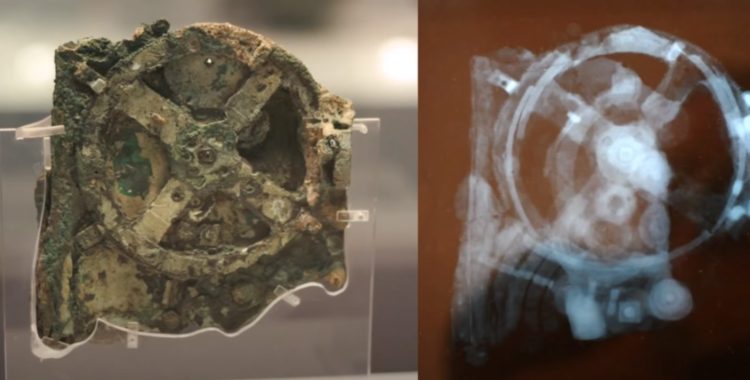When you think about computers, how far do you go back in time? Perhaps the early 19th century? But did you know that computers were produced way before then? The oldest known computer is “Antikythera,” and it was made in Greece. Scholars came to know about Antikythera in 1901 when they found it on a Roman-era shipwreck. The device is 2000 years old. Since its founding, scientists have been trying to recreate the device to understand its mechanism.
It is truly inspiring to consider the capacity of the human brain. Even at a time when humans were thought of as mere hunter-gatherers, they were able to produce Antikythera.
In 1902, the device was identified as a gear device by Valerios Stais. It was found in a wooden box in a lump. The lump was then separated into 83 fragments. Four of the fragments contain gear, and others had inscriptions on them. The inscriptions do not tell you how to work the machinery, they only tell you what you are seeing on it. The largest gear is 5.1 inches and originally contained 223 teeth.
About Antikythera
Antikythera is a complex device that uses multiple gears for multiple purposes. Scientists believe that the device was constructed by Greek scientists. For now, scientists have only figured out the backside of the device; the front portion is still a mystery. The backside of the device shows the motion of five plants that were known when the device was constructed.
The device seems to be an eclipse and other astronomical event predictors. It could also have been used for a four-year cycle of ancient Olympic games. When the device was found, only a third of it was left. This is why the look of the device can’t be recreated as well.
3D Computer Modeling
Scientists at UCL believe that they have been successful in constructing a 3D model of Antikythera. Using that model, they have recreated the front panel of the device, and now hope that they will be able to make an entire replica of
Antikythera. Soon after the statement, a scientific report published Antikythera’s gearing system. The display shows a strong gearing system and the complexity of its parts.
Regarding the recreated model, Professor Tony Freeth, the lead author of the paper, stated that the display of the sun, moon, and other planets shows the brilliance of the Greeks. He also states that this model is the first one that was successful in creating the entire device, which matches the scientific inscription engraved on the device itself.
Although Antikythera was used as an astronomical calculator, it is also the first analog computer in the world. The device includes several gears and is made of bronze.
The remains of the Antikythera device are kept in the National Archaeological Museum in Athens with some replicas to demonstrate how it would have looked and worked during that time.
Discovery and Origin
Captain Dimitrios Kontos and his crew found the shipwreck 148ft deep from where the device was retrieved. Along with Antikythera, artifacts such as bronze and marble statues, jewelry, coins, glassware, pottery, and tools were also retrieved. The artifacts were found on a cargo ship. There is a theory that all it was looted goods being taken to Rome. According to another theory, the ship contained expensive objects to sell to the nobles as gifts or goods for sale. All the artifacts were safely transferred to the National Museum of Archaeology in Athens for analysis and storage. The valuable items consisting of lumps in a wooden box went unnoticed for two years.
In 2012 and 2015, there were more searches near the shipwreck site where some other artifacts and one more ship was found. It is not certain if the ship connects with the ship where Antikythera was found, but a bronze disc with a picture of a bull on it – with four ears and holes – was found. The disc is believed to be a part of Antikythera. There are not many pieces of evidence supporting this theory, however. The disc could be a part of a piece of furniture or some statue decoration.
The Workings of Antikythera
After trying to revive Antikythera using various methods, scientists were successful in making some replicas. The replicas show that it had two bronze faces on opposite sides. One face had a pointed dial that indicated the date according to the Egyptian calendar and the positions of the zodiac. The other dial showed the movements of the moon. On the other face, there were two major dials. One dial represented the date position according to the Metonic cycle. The other dial represented the lunar and solar eclipses during a saros cycle.
According to inscriptions found on the device, one dial represented the moon’s color, eclipse, and weather condition on each day. In modern times, it is possible to predict an eclipse way before its time, but the color of the moon or weather conditions cannot be predicted beforehand with much success. According to the ancient Greeks, all three of these things were interconnected. An eclipse represented an omen. It could bring famine, war, or uprising. It makes sense as Antikythera is a mixture of science, culture, religion, and beliefs.
The Antikythera mechanism is a wonder and so far ahead of its time. The first theories of it being an analog computer were discarded as it was so advanced. But the more analyses were done, the more evidence was found that it was, in fact, an analog computer. Since the day of its discovery, scientists have been trying to recreate Antikythera to figure out what it was capable of. Right before the end of their civilization, the ancient Greeks were so close to our age. It is almost eerie to think of.

